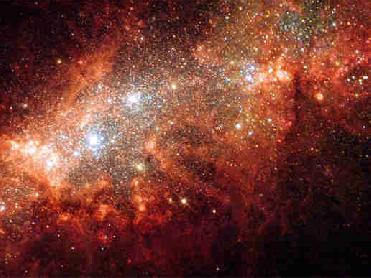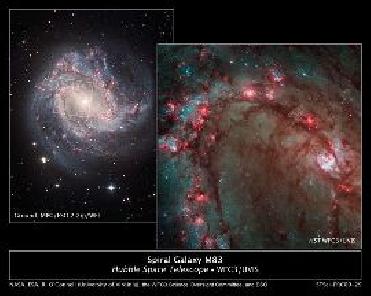
Supernova Blast Bonanza in Nearby Galaxy. Image Credit:NASA/Hubble
NEW DELHI (BNS): Astronomers have rediscovered an unusual supernova in seven-year-old data which may be the first example of a new type of exploding star.
A report by the Science Daily said, the rapid supernova was earlier detected in 2002 in the galaxy NGC 1821, in the constellation Lepus, but the supernova was erroneously classified by the astronomical community as a common Type II supernova and filed away.
Astronomers said the new class of exploding star occur possibly from a binary star system where helium flows from one white dwarf onto another and detonates in a thermonuclear explosion.
University of California, Berkeley, and Lawrence Berkeley National Laboratory (LBNL) astronomer Dovi Poznanski and his colleagues describe the outburst, dubbed SN 2002bj, in a paper published in the journal Science Express, and why they believe it is a new type of explosion.
"This is the fastest evolving supernova we have ever seen," said Poznanski, a UC Berkeley post-doctoral fellow who recently joined LBNL's Computational Cosmology Center. "It was three to four times faster than a standard supernova, basically disappearing within 20 days. Its brightness just dropped like a rock."
This rapid drop, coupled with the supernova's faintness, the strong signature of helium in the spectrum of the explosion, the absence of hydrogen, and the possible presence of vanadium -- an element never previously identified in supernova spectra -- points toward helium detonation on a white dwarf, the astronomers said.
"We think this may well be a new physical explosion mechanism, not just a minor variation of ones already known," said co-author Alex Filippenko, UC Berkeley professor of astronomy. "This supernova is qualitatively different from the complete disruption of a white dwarf, known as a Type Ia supernova, or the collapse of an iron core and rebound of the surrounding material, so-called 'core-collapse supernovae.'
Poznanski stumbled upon the spectrum while searching for Type II supernovae he hopes to use as distance indicators to confirm the accelerating expansion of the universe. When he carefully examined a high-quality spectrum of SN 2002bj, he found that the supernova was not a Type II at all, but an unusual kind of supernova more akin to a Type Ia, the report said.
Filippenko noted that this explosion is nothing like a regular Type Ia explosion because the white dwarf survives the detonation of the helium shell. In fact, it has similarities to both a nova and a supernova. Novas occur when matter -- primarily hydrogen -- falls onto a star and accumulates in a shell that can flare up as brief thermonuclear explosions. SN 2002bj is a "super" nova, generating about 1,000 times the energy of a standard nova, he said.
 Previous Article
Previous Article













The Indian Air Force, in its flight trials evaluation report submitted before the Defence Ministry l..
view articleAn insight into the Medium Multi-Role Combat Aircraft competition...
view articleSky enthusiasts can now spot the International Space Station (ISS) commanded by Indian-American astr..
view article